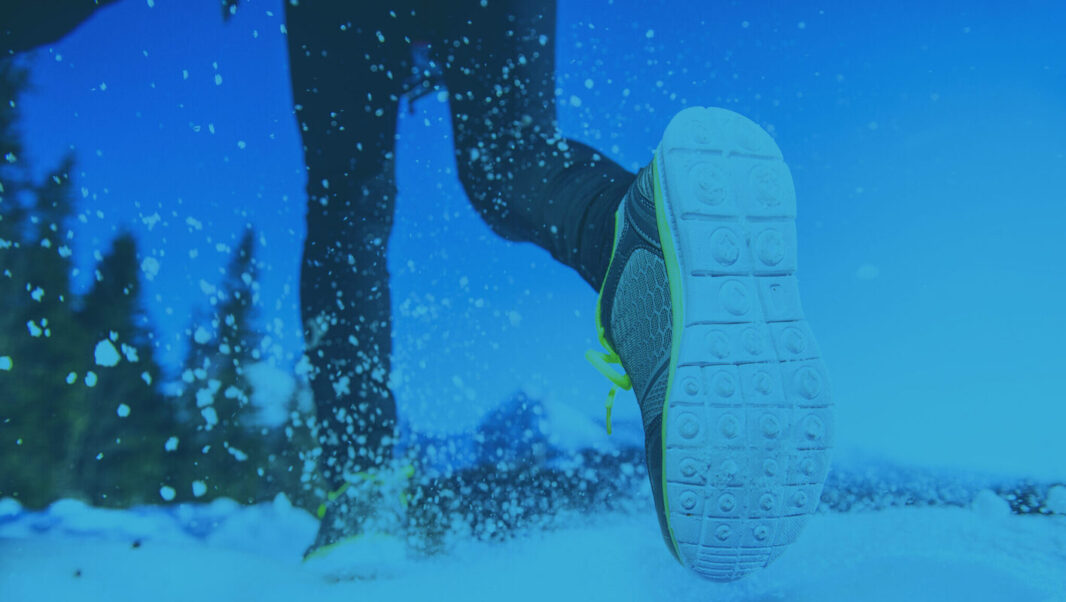Exercising Into Thin Air
Effects of and strategies for working out at altitude.

Altitude is mysterious. Part of the mystery comes from the fact that altitude escapes all of our senses—we can’t see it, taste it, smell it, hear it or touch it. But we can feel it. Most of the time, we don’t even think about altitude, except when we take a ski trip or hike up a mountain. We certainly think about it then, since we can hear our increased breathing and feel that our bodies suddenly are out of shape.
Altitude commonly refers to any level of elevation above sea level. But for this article, exercise “at altitude” refers to exercise at and above 3,000 feet. Although altitude presents a unique stress not experienced at sea level, tolerance of moderate altitude is ancestral for humans (Hochachka, Gunga & Kirsch 1998; Hochachka & Monge 2000). The evolution of our physiology, which has at its roots the African highlands, was inherently dependent on efficient oxygen delivery and on the development of aerobic metabolic pathways, with a relatively minor dependence on anaerobic metabolism (Hochachka, Gunga & Kirsch 1998).
As attempts to climb Mount Everest have shown, it is a remarkable coincidence that the highest elevation that can be tolerated by humans coincides with the highest point on Earth (29,035 feet or 8,850 meters). Even though the ability to cope with altitude is in our genes, many people still have trouble tolerating it. Many places in the world, especially popular winter vacation destinations, are at altitude—so knowing how to handle it will help your clients perform at their best.
The Physiology of Altitude
When you arrive at altitude, one of the first things you notice is that you breathe more heavily. The increased breathing is the obvious indication of a number of subtle changes in your body: your blood’s oxygen content, blood plasma, total blood volume and stroke volume (the volume of blood pumped by your heart per beat) are all reduced, while fluid loss, resting heart rate and resting metabolic rate are all increased (Robergs & Roberts 1997).
On your first day at altitude you go for a run, and you notice within a few strides that you are breathing more heavily than usual. You wonder why, because the air still contains 20.93% oxygen—whether you are swimming in the Dead Sea in Israel (1,369 feet or 417 meters below sea level) or standing on top of Mount Everest in Nepal (29,035 feet or 8,850 meters above sea level).
Besides the beautiful scenery and clean mountain air, the defining characteristic of altitude is a lower barometric pressure, which keeps decreasing the higher up you go. As a result, the partial pressure of oxygen in the air is reduced, resulting in less oxygen entering the lungs with each breath (Robergs & Roberts 1997). To compensate, your ventilation increases in an attempt to take in more oxygen. Not even 1 mile into your run, you feel so out of breath that you begin to question whether those fitness boot camps you’ve been leading back home at sea level are making any difference to your and your clients’ fitness levels.
Besides making you feel like you’re working harder, the increased breathing has a physiological consequence. Since you exhale carbon dioxide with each breath, your increased ventilation decreases the partial pressure of carbon dioxide in your blood, altering your acid-base balance by elevating the pH (the number value of the acidity/alkalinity of a solution). In response to this respiratory alkalosis, your kidneys compensate by excreting bicarbonate (your body’s buffer to acidosis) to lower your blood pH back to its normal physiological value and maintain your acid-base balance. So, rather than collecting a urine sample to check its bicarbonate concentration, you decide to trust your kidneys to do their job.
About 2 miles into your run, your legs feel sluggish. When the oxygen partial pressure in your lungs decreases, the oxygen pressure gradient between your lungs and your blood also decreases. Since molecules travel from areas of higher pressure to areas of lower pressure, the smaller pressure gradient decreases the amount of oxygen diffusing into your blood, and blood oxygen saturation is reduced. Less oxygen traveling around in your blood means less oxygen available to your skeletal muscles. Less oxygen, together with a reduced blood volume that reduces stroke volume, decreases your aerobic power (VO2max) at altitude compared to at sea level (Koistinen et al. 1995; Lawler, Powers & Thompson 1988; Martin & O’Kroy 1993).
Interestingly, research has shown that individuals who are very aerobically fit and have a high VO2max at sea level experience a greater reduction in VO2max at altitude compared with less fit individuals, because fitter people exhibit a greater decrease in blood oxygen saturation at altitude (Koistinen et al. 1995; Lawler, Powers & Thompson 1988; Martin & O’Kroy 1993). It seems that the more you have to begin with, the more you have to lose. Since VO2max is lower at altitude, exercising at the same intensity as at sea level will feel harder because you’re working at a higher percentage of your (altitude) VO2max. Metabolism during submaximal aerobic exercise is also altered when you are exercising at altitude at the same absolute intensity as at sea level, with a greater reliance on glycolysis (Brooks et al. 1991; Howald et al. 1990; Roberts et al. 1996).
At 3 miles into your run, you don’t think you can go much farther. You finally get back to your hotel and realize that you are very thirsty. Since you’re breathing more, you’re not just losing carbon dioxide; you’re also losing water through your breath. As a result, you now must deal with dehydration, in addition to both thermal and cardiovascular strain and reduced exercise performance.
A few hours later, you have a slight headache. Exposure to moderate to extreme altitudes can result in acute mountain sickness, a condition characterized by headaches, nausea, loss of appetite and lethargy (Armstrong 2000). Exercise can exacerbate the symptoms of acute mountain sickness (Roach et al. 2000); usually, the symptoms are alleviated with supplemental oxygen, drugs or a return to lower altitude (Armstrong 2000).
The next day, you’ve had enough with the heavy breathing and sluggish legs and you try to do some hill sprints. After the first sprint, you can’t believe how good your legs feel. You try another sprint, thinking it may just be a fluke. Again, you feel like you’re flying up the hill. You think, “How can this be? Just yesterday I could not even breathe and today I’m flying!”
The difference between aerobic exercise and anaerobic exercise is seen most clearly at altitude. Anaerobic exercise, including sprinting, jumping and plyometrics, is positively affected by altitude because the air is less dense (Coudert 1992; Fulco, Rock & Cymerman 1998). Those activities do not depend on oxygen, so it makes little difference during hill sprints that there’s less oxygen available (resistance training also is not affected by altitude). Aerobic exercise, as you discovered during your easier but longer run the day before, is dependent on oxygen, so having less oxygen available during aerobic activities makes all the difference. The magnitude of aerobic performance impairment at altitude is proportional to both the elevation and the duration of the activity (Fulco, Rock & Cymerman 1998; Strauzenberg 1976).
Training Response to Altitude
Living and exercising at altitude stimulate the production of red blood cells (a process called erythropoiesis, after erythropoietin, the hormone that stimulates red blood cell production). This is part of acclimatization to compensate for the decreased oxygen; it also gives your blood a greater oxygen-carrying capability when you return to sea level. However, acclimatization to altitude does not completely counteract the fundamental stress of performing at altitude. Changes in your cardiovascular system do not return to what is characteristic at sea level. This prevents you from exercising at the same aerobic intensity at altitude as you can at sea level.
This issue, most problematic for endurance athletes, has led to an interesting area of research. The research suggests that, to acquire the benefit of both worlds, it is better for endurance athletes to live at altitude to stimulate the production of red blood cells, but train at sea level to maintain a greater training intensity, a strategy called “live high/train low” (Levine & Stray-Gundersen 1997).
Recommendations for Exercising at Altitude
Intensity. Since the same aerobic intensity will feel harder at altitude than at sea level owing to the reduction in VO2max at altitude, adjust your clients’ exercise intensity at altitude to make their workouts physiologically equivalent to their workouts at sea level (see the sidebar “Adjusting Exercise Intensity at Altitude”).
To maintain sea level training intensity (and thus fitness) while at altitude, incorporate “sea level speed” interval workouts. Have your clients run or bike at the same speed as at sea level, but shorten the intervals so they can maintain their sea level speed.
For example, if a client normally runs half-mile repeats at sea level in 3:30 (7-minute mile pace), tell the client to run quarter-mile repeats at altitude in 1:45 (7-minute mile pace). Do the same for indoor cycling classes: decrease the duration of the higher-intensity segments to maintain the same intensity as at sea level. Clients may also require longer recovery periods during interval workouts at altitude.
With the less dense air of altitude, your clients can benefit greatly from anaerobic workouts since they can sprint faster at altitude than at sea level. However, decrease the frequency of high-intensity workouts, since it takes longer to recover at altitude (recovery is an aerobic process).
Nutrition. Since resting metabolic rate increases at altitude and muscles rely more on carbohydrates at altitude than at sea level, your clients should increase their caloric intake, especially carbohydrates. They should also drink fluids before and during exercise to prevent dehydration. Finally, clients should consume adequate antioxidants (vitamins A, C and E) to bolster their immune systems. In particular, altitudes above 14,000 feet (4,267 meters) (Chao et al. 1999) may weaken the immune system, which can increase the risk of upper respiratory tract infections.
Competing at Altitude. If you have a client who will be doing an endurance event at altitude, the two of you need to consider a few things. The higher the elevation and the longer the race, the greater the decline in performance, so your client cannot expect to race at the same speed as at sea level. Starting the race at sea level speed will only cause a greater amount of fatigue. Unless your client is able to train at altitude for at least 2 weeks before the event, plan to arrive at the location as close as possible to the day of the race. The physiological changes that occur at altitude exhibit their greatest detrimental effect on performance after 10–14 days of exposure (Strauzenberg 1976). Over the few weeks following that, your client acclimatizes and the consequence of those changes becomes less severe.
The next time your clients exercise at altitude, make sure they follow these guidelines. And if they “train smart enough,” not only will they get more out of their workouts and eliminate their risk of acute mountain sickness, but they may even be able to demystify altitude.
Endurance performance doesn’t begin to decline until about 3,000 feet above sea level. So if your client is traveling to an altitude below 3,000–3,500 feet (914–1,067 meters), you may not have to adjust the intensity of the workouts. For clients traveling to altitudes higher than 3,000 feet, research has shown that VO2max decreases by about 2.6% for every 1,000 feet of altitude above 3,400 feet (Robergs & Roberts 1997). Here’s how to calculate running speeds for altitude workouts:
# of feet at altitude − 3,400 feet = A
A × 0.026 / 1,000 feet = B
B × sea level pace in minutes = C
C + sea level pace in minutes = new altitude pace in minutes
Convert decimal from new altitude pace into seconds by multiplying decimal by 60 = new altitude pace.
For example, at an altitude of 5,000 feet (1,524 meters) and a sea level pace of 7:00:
5,000 feet – 3,400 feet = 1,600 feet
1,600 × 0.026 / 1,000 feet = 0.0416
0.0416 × 7.0 = 0.2912
0.2912 + 7.0 = 7.2912 minutes
0. 2912 × 60 = 17 seconds = 7:17 pace
If a client lives at altitude and is traveling to sea level, subtract the time from the altitude pace to find the sea level pace, since your client will be faster at sea level than at altitude. As there is considerable variability in the altitude response of individuals, you may have to adjust the intensity based on your client’s individual response to altitude.
References
Armstrong, L.E. 2000. Performing in Extreme Environments. Champaign, IL: Human Kinetics.
Brooks, G.A., et al. 1991. Increased dependence on blood glucose after acclimatization to 4,300 m. Journal of Applied Physiology, 70 (2), 919–27.
Chao, W.-H., et al. 1999. Oxidative stress in humans during work at moderate altitude. Journal of Nutrition, 129, 2009–12.
Coudert, J. 1992. Anaerobic performance at altitude. International Journal of Sports Medicine, 13 (Suppl. 1), S82–85.
Fulco, C.S., Rock, P.B., & Cymerman, A. 1998. Maximal and submaximal exercise performance at altitude. Aviation, Space, and Environmental Medicine, 69 (8), 793–801.
Hochachka, P.W., Gunga, H.C., & Kirsch, K. 1998. Our ancestral physiological phenotype: An adaptation for hypoxia tolerance and for endurance performance? Proceedings of the National Academy of Sciences, 95, 1915–20.
Hochachka, P.W., & Monge, C. 2000. Evolution of human hypoxia tolerance physiology. Advances in Experimental Medicine and Biology, 475, 25–43.
Howald, H., et al. 1990. Effect of chronic hypoxia on muscle enzyme activities. International Journal of Sports Medicine, 11 (Suppl. 1), S10–14.
Koistinen, P., et al. 1995. Aerobic fitness influences the response of maximal oxygen uptake and lactate threshold in acute hypobaric hypoxia. International Journal of Sports Medicine, 16 (2), 78–81.
Lawler, J., Powers, S.K., & Thompson, D. 1988. Linear relationship between VO2max and VO2max decrement during exposure to acute hypoxia. Journal of Applied Physiology, 64 (4), 1486–92.
Levine, B.D., & Stray-Gundersen, J. 1997. “Living high-training low”: Effect of moderate-altitude acclimatization with low-altitude training on performance. Journal of Applied Physiology, 83 (1), 102–12.
Martin, D., & O’Kroy, J. 1993. Effects of acute hypoxia on the VO2max of trained and untrained subjects. Journal of Sports Sciences, 11 (1), 37–42.
Roach, R.C., et al. 2000. Exercise exacerbates acute mountain sickness at simulated high altitude. Journal of Applied Physiology, 88, 581–85.
Robergs, R.A., & Roberts, S.O. 1997. Exercise Physiology: Exercise, Performance, and Clinical Applications. New York: William C. Brown.
Roberts, A.C., et al. 1996. Acclimatization to 4,300-m altitude decreases reliance on fat as a substrate. Journal of Applied Physiology, 81 (4), 1762–71.
Strauzenberg, E. 1976. Short outline of the problem of competition at altitude above 2000 M. The Journal of Sports Medicine and Physical Fitness, 16 (4), 346–47.
Jason Karp, PhD
A professional running coach, freelance writer, fitness consultant and PhD candidate in exercise physiology at Indiana University. He coaches runners of all levels through RunCoachJason.com.





